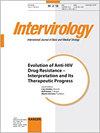Bunyaviridae.
IF 1.8
4区 医学
Q3 VIROLOGY
引用次数: 0
Abstract
The family Bunyaviridae comprises over 200 viruses (serotypes, subtypes, and varieties) that infect vertebrates and/or invertebrates. Four genera of viruses have been defined (Bunyavirus, Nairovirus, Phlebovirus, and Uukuvirus). The main characteristics of the member viruses are: (i) the virus particles are for the most part uniformly spherical, 80-110 nm in diameter, and possess a unit membrane envelope from which protrude polypeptide spikes 5-10nm long; (ii) the viruses have three helical nucleocapsids, often in the form of supercoiled circles, each consisting of a single species of single-stranded RNA, major nucleocapsid polypeptide, N, and at least in some cases minor amounts of a large polypeptide which may be a transcriptase component; (iii) the genome is composed of three species of RNA (L, large; M, medium; and S, small), organized in end-hydrogen bonded circular structures; (iv) most viruses have three major virion polypeptides (N, and two surface polypeptides, designated G1 and G2); (v) for at least some member viruses, the virions have been shown to contain an RNA-directed RNA polymerase, believed to be responsible for the synthesis of viral complementary mRNA, so that bunyaviruses are considered to be negative-stranded viruses; (vi) at least some bunyaviruses are capable of heterologous virus genome segment reassortment and can form recombinant viruses at high or low frequency; (vii) viruses appear to mature primarily at smooth membrane surfaces and accumulate in Golgi vesicles and saccules, or nearby; (viii) transovarial, venereal and/or transstadial transmission in arthropods has been shown to occur for some members of the family.布尼亚病毒科。
布尼亚病毒科包括200多种感染脊椎动物和/或无脊椎动物的病毒(血清型、亚型和变种)。已经确定了四个病毒属(布尼亚病毒、奈罗病毒、Phlebovirus和Uukuvirus)。成员病毒的主要特征是:(i)病毒颗粒大部分是均匀的球形,直径80-110nm,并具有单位膜包膜,从其突出5-10nm长的多肽尖峰;(ii)病毒具有三个螺旋核衣壳,通常为超螺旋圈的形式,每个螺旋核衣壳体由单链RNA、主要核衣壳多肽N和至少在某些情况下少量的可能是转录酶组分的大多肽组成;(iii)基因组由三种RNA组成(L,大;M,中等;和S,小),以末端氢键环状结构组织;(iv)大多数病毒具有三种主要的病毒体多肽(N和两种表面多肽,命名为G1和G2);(v) 对于至少一些成员病毒,病毒粒子已被证明含有RNA导向的RNA聚合酶,被认为负责病毒互补信使核糖核酸的合成,因此布尼亚病毒被认为是负链病毒;(vi)至少一些布尼亚病毒能够异源病毒基因组片段重组,并且能够以高频率或低频率形成重组病毒;(vii)病毒似乎主要在光滑的膜表面成熟,并在高尔基体小泡和囊状体中或附近积聚;(viii)节肢动物的经阴道、性病和/或经阴道传播已被证明发生在该家族的一些成员身上。
本文章由计算机程序翻译,如有差异,请以英文原文为准。
求助全文
约1分钟内获得全文
求助全文
来源期刊

Intervirology
医学-病毒学
CiteScore
5.40
自引率
0.00%
发文量
13
审稿时长
6-12 weeks
期刊介绍:
''Intervirology'' covers progress in both basic and clinical virus research, and aims to provide a forum for the various disciplines within virology. Issues publishing original papers alternate with thematic issues, focusing on clearly defined topics. This thematic concentration serves to make timely reviews, research reports and controversy easily accessible to both specialists in the field and those who want to keep track of the latest developments outside their own area of interest. In addition to original papers, regular issues publish short communications and letters to the editor to provide readers with a forum for the exchange of ideas and comments. The scope encompasses work on the molecular biology of human and animal viruses, including genome organization and regulation, and the structure and function of viral proteins. The pathogenesis, immunology, diagnosis, epidemiology, prophylaxis and therapy of viral diseases are considered.
 求助内容:
求助内容: 应助结果提醒方式:
应助结果提醒方式:


